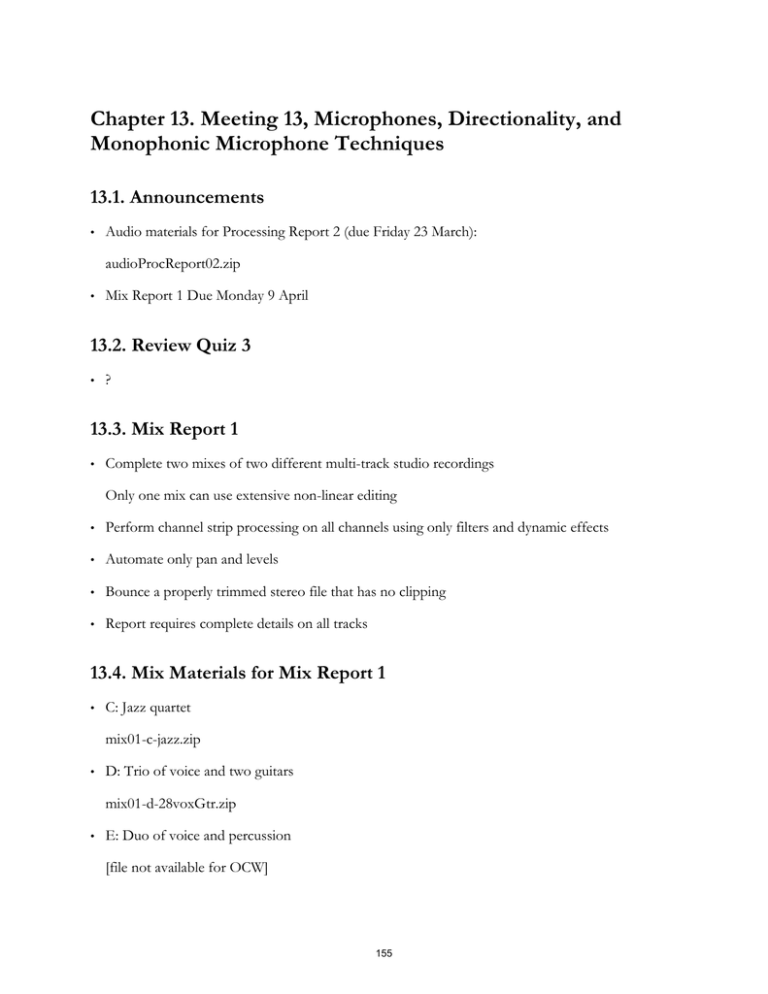
Chapter 13. Meeting 13, Microphones, Directionality, and
Monophonic Microphone Techniques
13.1. Announcements
•
Audio materials for Processing Report 2 (due Friday 23 March):
audioProcReport02.zip
•
Mix Report 1 Due Monday 9 April
13.2. Review Quiz 3
•
?
13.3. Mix Report 1
•
Complete two mixes of two different multi-track studio recordings
Only one mix can use extensive non-linear editing
•
Perform channel strip processing on all channels using only filters and dynamic effects
•
Automate only pan and levels
•
Bounce a properly trimmed stereo file that has no clipping
•
Report requires complete details on all tracks
13.4. Mix Materials for Mix Report 1
•
C: Jazz quartet
mix01-c-jazz.zip
•
D: Trio of voice and two guitars
mix01-d-28voxGtr.zip
•
E: Duo of voice and percussion
[file not available for OCW]
155
•
F: Duo of voice and piano
mix01-f-46voxPno.zip
•
A: Shimauta
[file not available for OCW]
•
G: NIN
[file not available for OCW]
13.5. Transducers and Transduction
•
Transduction: conversion of one form of (sound) energy to another form
•
Microphones and Speakers
•
Transducers always act as a filter
•
A frequency domain graph (frequency response curve) is used to show the effect of transduction
13.6. Microphones: Numerical Specifications
•
Frequency response curves
•
Transient response
•
Self-noise
1. Identify the microphones internal noise floor
•
Sensitivity
1. Given as negative dB: -57 dB
2. Amount of boost required to raise input to 0 dBu
3. A higher number means a more sensitive microphone
•
Maximum SPL
•
DPA 4006
156
© DPA Microphones. All rights reserved. This content is excluded from our Creative
Commons license. For more information, see http://ocw.mit.edu/fairuse.
13.7. Visualizing the Affect of Transduction: Examples
•
Shure SM-57
157
© Shure Inc. All rights reserved. This content is excluded from our Creative
Commons license. For more information, see http://ocw.mit.edu/fairuse.
•
Shure 55SH
158
© Shure Inc. All rights reserved. This content is excluded from our Creative
Commons license. For more information, see http://ocw.mit.edu/fairuse.
13.8. Microphones
•
First stage of transduction
•
Permanently alters the sound of the source
•
Primary considerations: microphone type, microphone position, acoustical environment
159
13.9. Microphones: Directional Response
•
Microphones pick up sound in various patterns (due to pressure or pressure gradient)
•
Called polar pattern, pickup pattern, or directional response
•
Microphones have a “front” or primary point of address, called on-axis
•
Degrees are used to describe off-axis position (reverse is 180 degrees off-axis)
•
Pickup patterns are in expanding three-dimensional spaces
•
Different pickup patterns have different directional “pull” (sensitivity, or direcitional response)
13.10. Microphones: Directional Response Types
•
Omnidirectional
1. Gather sound from all around
2. Called an “omni”
3. Useful for gather reflections and space of a sound
4. Not considered a “directional” microphone
5. No proximity effect
•
Bidirectional
1. Gather sound from two sides
2. Called a “figure-eight”
3. Useful for complete side rejection and rejection
4. Useful for capturing reverse reflections
5. Useful for getting two sources into one channel
6. Useful for the sides of a mid/side stereo recording
7. Common polarity of ribbon microphones (pressure gradient)
8. Proximity effect
•
Unidirectional
1. Gather sound from one primary direction
160
2. Useful for focusing in on a singular sound source
3. Various types of cardiods: reject sound form the rear
4. Proximity effect
•
Some microphones have variable patterns with switches or interchangeable capsules
13.11. Directional Response in 2D and 3D
•
Three dimensional presentation
© Hal Leonard Corp. All rights reserved. This content is excluded from our Creative
Commons license. For more information, see http://ocw.mit.edu/fairuse.
Source: Gibson, B. Microphones & Mixers. 2007.
•
Two dimensional presentation
161
© Hal Leonard Corp. All rights reserved. This content is excluded from our Creative
Commons license. For more information, see http://ocw.mit.edu/fairuse.
Source: Gibson, B. Microphones & Mixers. 2007.
•
Cardiods in two dimensions
162
© Hal Leonard Corp. All rights reserved. This content is excluded from our Creative
Commons license. For more information, see http://ocw.mit.edu/fairuse.
Source: Gibson, B. Microphones & Mixers. 2007.
13.12. Directional Response: Frequency Dependence
•
Directional response is not the same for all frequencies
163
© Hal Leonard Corp. All rights reserved. This content is excluded from our Creative
Commons license. For more information, see http://ocw.mit.edu/fairuse.
Source: Gibson, B. Microphones & Mixers. 2007.
13.13. Directional Response: Characteristics of Cardiods
•
Directional response summarized
Key value is the distance factor
164
Image removed due to copyright restrictions.
Characteristics of first-order cardioid microphones, Figure 5-4, in
Eargle, J. The Microphone Book. 2nd ed. Focal Press, 2004.
•
A greater distance factor means a greater directional pull
•
Equal-amplitude distance chart
165
Image removed due to copyright restrictions.
Distance factor illustration for first-order cardioid microphones, Figure 5-5, in
Eargle, J. The Microphone Book. 2nd ed. Focal Press, 2004.
13.14. Proximity Effect
•
Bass frequencies are exagerated when very close to directional (cardiod or figure-eight)
microphones
•
Low cut filters are often provided on microphones to mitigate
166
36
Response (dB)
30
24
18
12
54 cm
27 cm
10.8 cm
5.4 cm
6
0
12.5
25
50
100
200
500
Frequency (Hz)
1k
2k
5k
Graph of the proximity effect vs. distance for a cardioid microphone, on axis.
Image by MIT OpenCourseWare.
13.15. Microphone Parts and Species
•
Diaphragm
•
Large: greater than a few centimeters
•
Small
•
Smaller diaphragms have less off-axis coloration
•
Capsule: contains diaphragm as well as mount and possibly a pre-amp
•
Transduction Method
•
•
Magnetic Induction
•
Variable Capacitance
Transducer Type
•
Condenser (Variable Capacitance)
•
Moving Coil or Dynamic (Magnetic Induction)
•
Ribbon (Magnetic Induction)
167
13.16. Transduction Methods: Magnetic Induction
•
Electromagnetic force
•
Moving metal in a magnetic field produces voltages
•
Induce a voltage with a magnet
•
Used in ribbon and dynamic mics
•
Do not require power to operate
13.17. Transduction Methods: Variable Capacitance
•
Electrostatic force
•
Two closely-spaced, parallel plates: one fixed, one acts as a diaphragm
•
Stored charge, between plates, varies due to acoustical pressure
•
Requires power to charge plates (usuall 48 V phantom power)
•
Output is very small small; must be amplified in microphone
13.18. Transducer Type: Dynamic
•
Metal is a coil attached to a diaphragm that moves within a magnetic field
168
Diaphragm
Microphone Output Leads
Magnets
Image by MIT OpenCourseWare.
•
Have big magnets: heavy
•
Diaphragm must move relatively large distance: slower transient response
169
•
Durable, can handle high SPLs
•
May color sound between 5 and 10 kHz
•
Often used in close-miking, within a foot of source; can be very close
•
Phantom power not necessary, does not hinder performance
13.19. Transducer Type: Dynamic: Examples
•
Shure SM-57
© Shure Inc. All rights reserved. This content is excluded from our Creative
Commons license. For more information, see http://ocw.mit.edu/fairuse.
•
Sennheiser MD-421
170
© Sennheiser. All rights reserved. This content is excluded from our Creative
Commons license. For more information, see http://ocw.mit.edu/fairuse.
13.20. Transducer Type: Ribbon
•
Metal is a thin ribbon
171
Ribbon
Microphone output
leads
Magnets
Image by MIT OpenCourseWare.
•
Ribbon suspended between poles of a magnet
•
Old ribbon mics were very fragile and unreliable
•
Newer models are better
•
Known for warm sound when used in close proximity
•
Phantom power can cause old models to fry
13.21. Transducer Type: Ribbon: Examples
•
AEA R92
172
•
Royer R-122
© Audio Engineering Associates (top), Royer Labs (bottom). All rights reserved. This content is excluded
from our Creative Commons license. For more information, see http://ocw.mit.edu/fairuse.
13.22. Transducer Type: Condenser
•
Delicate and accurate
•
Diaphragm must move relatively small distance: fast transient response
173
© Audio-Technica U.S., Inc. All rights reserved. This content is excluded from our
Creative Commons license. For more information, see http://ocw.mit.edu/fairuse.
174
Neumann center-clamped condenser microphone capsule. © Neumann/USA. All rights reserved. This content is
excluded from our Creative Commons license. For more information, see: http://ocw.mit.edu/fairuse.
Condenser Microphone
Diaphragm
Insulating Ring
Capsule
Case
Output leads
Backplate
Sound Pressure
Sound Pressure
Decrease Capacitance
Increase Potential
Increase Capacitance
Decrease Potential
Image by MIT OpenCourseWare.
•
Often offers less coloration
•
Do not have to be very close to get an intimate sound
•
Phantom power necessary
•
Internal pre-amp may be transistor- or tube-based
175
13.23. Transducer Type: Condenser: Examples
•
AKG C 414 BXL II/ST
© AKG Acoustics GmbH. All rights reserved. This content is excluded from our Creative
Commons license. For more information, see http://ocw.mit.edu/fairuse.
•
AudioTechnica AT 4050
176
© Audio-Technica U.S., Inc. All rights reserved. This content is excluded from our
Creative Commons license. For more information, see http://ocw.mit.edu/fairuse.
•
Neumann M149
177
© Neumann/USA. All rights reserved. This content is excluded from our Creative
Commons license. For more information, see: http://ocw.mit.edu/fairuse.
13.24. Reading: Streicher: The Bidirectional Microphone: A Forgotten
Patriarch
•
Omni-directional microphones are pressure microphones: respond only to pressure; diaphragm
covers a sealed chamber
178
•
Bi-directional microphones have a diaphragm exposed on both sides: responds to difference (or
gradient) in pressure; sometimes called velocity
•
A cardioid (directional) pattern can be created by combining omni and bidirectional patterns
•
All polar patterns can be derived from combination of omni and bi-directional
© Audio Engineering Society. All rights reserved. This content is excluded from our
Creative Commons license. For more information, see http://ocw.mit.edu/fairuse.
•
Earliest variable polar pattern microphone (RCA 77A) did this mechanically with a diaphragme
divided into two parts
179
© Audio Engineering Society. All rights reserved. This content is excluded from our Creative Commons
license. For more information, see http://ocw.mit.edu/fairuse.
Source: Olson, H. F. " A History of High-Quality Studio Microphones." WK Convention of the AES 24 (1976): 862.
180
•
Many modern capacitor mics that offer multiple patters used two cardioid diaphragms back to
back and vary amplitude of components
13.25. Recording Instruments: Study, Experience, and Experimentation
•
Conventional approaches based on practice and experience
•
Creative approaches based on experimentation
•
Walk around and listen
•
Thinking of sound in three dimensions
1. Three dimensional radiation
2. Sound takes time to travel: 1.13 foot per millisecond (331 m/s)
3. Sound travels in space: amplitudes diminish with distance
4. Reflections matter: opportunities for comb filtering / phasing distortion
181
MIT OpenCourseWare
http://ocw.mit.edu
21M.380 Music and Technology: Recording Techniques and Audio Production
Spring 2012
For information about citing these materials or our Terms of Use, visit: http://ocw.mit.edu/terms.




